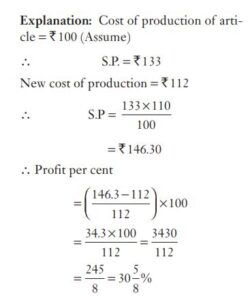Profit and Loss Questions with Answer and Solutions : Practice Mock Test for Competitive Exams. Quantitate Aptitude (Maths) MCQs for SSC CGL, CHSL, SSC GD, Bank, UPSSSC PET examinations.
Quiz : Profit and Loss
Subjects : Mathematics
MCQ Questions with Solutions
Results
#1. By selling 144 hens Mahesh suffered a loss equal to the selling price of 6 hens. His loss percent is :

#2. A sells a cycle to B at a profit of 20% and B sells it to C at a loss of 25%. If C bought the cycle for Rs. P, then the cost price of it for A was :

#3. A man purchased an article and sold it to B at a profit of 25% and B sold it to C at a loss of 10% and C paid Rs 675 for it. For how much did A purchase it (in Rs)?

#4. A shopkeeper sells an article at 15% gain. Had he sold it for Rs 18 more, he would have gained 18%. The cost price (in Rs) of the article is

#5. A fruit merchant makes a profit of 25% by selling mangoes at a certain price. If he charges Rs 1 more on each mango, he would gain 50%. At first the price of one mango was :

#6. If there is a profit of 20% on the cost price, the percentage of profit on the sale price is :

#7. A retailer buys a radio for Rs 225. His overhead expenses are Rs 15. He sells the radio for Rs 300. The profit per cent of the retailer is :
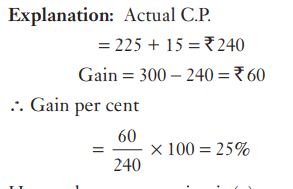
#8. An item when sold for Rs 1690 earned 30% profit on the cost price. Then the cost price is :

#9. Krishnan bought a camera and paid 20% less than its original price. He sold it at 40% profit on the price he had paid. The percentage of profit earned by Krishnan on the original price was :

#10. A man bought an old type writer for Rs 1200 and spent Rs 200 on its repair. He sold it for Rs 1680. His profit per cent is :

#11. On selling an article for Rs 651, there is a loss of 7%. The cost price of that article is :

#12. The cost price of 100 books is equal to the selling price of 60 books. The gain percentage/loss percentage is :

#13. A shopkeeper sold his goods at half the list price and thus lost 20%. If he had sold on the listed price, his gain percentage would be.

#14. If the cost price of 10 articles equals selling price of 9 articles, the gain or loss percent will be :

#15. If the selling price of 4 articles is equal to the cost price of 5 articles, the profit per cent is :

#16. The cost price of 18 articles is equal to the selling price of 15 articles. The gain percent is :

#17. The cost price of 36 books is equal to the selling price of 30 books. The gain percent is :

#18. A manufacturer sells an item to a wholesale dealer at a profit of 18%. The wholesaler sells the same to a retailer at a profit of 20%. The retailer in turn sells it to a customer for Rs 15,045 thereby earning a profit of 25%. The cost price of the manufacturer is :

#19. By selling a tape-recorder for Rs 1040 a man gains 4%. If he sells for Rs 950, then his loss will be :

#20. Kamala bought a bicycle for Rs 1650. She had to sell it at a loss of 8%. She sold it for

#21. By selling an article for Rs 102, there is a loss of 15%, when the article is sold for Rs 134.40. The net result in the transaction is

#22. If I purchased 11 books for Rs 100 and sold 10 books for Rs 110, the percentage of profit per book sold is :

#23. A person buys 100 cups at Rs 10 each. On the way 10 cups are broken. He sells the remaining cups at Rs 11 each. His loss percent is :

#24. If the ratio of cost price to selling price is 10: 11, then the rate of percent of profit is

#25. Two types of tea costing Rs 180 per kg and Rs 280 per kg should be mixed in the ratio so that the mixture obtained was sold at Rs 320 per kg to earn a profit of 20% is
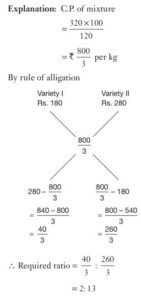
#26. A milkman makes 20% profit by selling milk mixed with water at Rs 9 per litre. If the cost price of 1 litre pure milk is Rs 10, then the ratio of milk and water in the said mixture is :
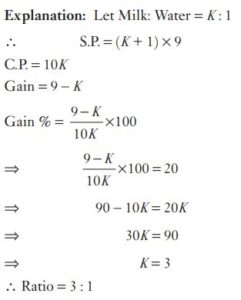
#27. Nita blends two varieties of tea one costing Rs 180 per kg and another costing Rs 200 per kg in the ratio 5 : 3. If she sells the blended variety at Rs 210 per kg, then her gain percent is :

#28. The ratio of cost price and selling price is 5 : 4, the loss percent is :

#29. A grocery dealer cheats to the extent of 10% while buying as well as selling by using false weight. What is his increase in the profit %?

#30. The salary of a person is increased by 20%, then it is decreased by 20%. The change in his salary is :

#31. Find the selling price of an article if a shopkeeper allows two successive discounts of 5% each on the marked price of Rs 80

#32. Sourav purchased 30 kg of rice at the rate of Rs 10 per kg and 35 kg at the rate of Rs 11 per kg. He mixed the two. At what price per kg (in Rs) should he sell the mixture to make a 30% profit in the transaction?

#33. A man bought 20 dozen eggs for Rs 720. What should be the selling price of each egg if he wants to make a profit of 20% ?
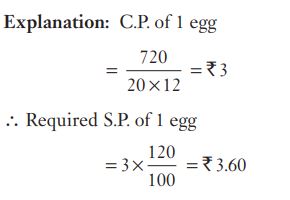
#34. By selling an article for Rs 69, there is a loss of 8%, when the article is sold for Rs 78, the gain or loss per cent is :

#35. On selling an article for Rs 105 a trader loses 9%. To gain 30% he should sell the article at

#36. Arvind purchased a wrist watch with 30% discount on the labelled price. He sold it with 40% profit on the price he bought. What was his per cent loss on the labelled price?

#37. A trader marked the price of a commodity so as to include a profit of 25%, but allowed a discount of 16% on the market price. His actual profit will be :

#38. To gain 8% after allowing a discount of 10%, by what percent cost price should be hiked in the list price?

#39. At what percent above the cost price, must a shopkeeper mark his goods so that he gains 20% even after giving a discount of 10% on the marked price?

#40. On selling 17 balls at Rs 720, there is a loss equal to the cost price of 5 balls. The cost price (in Rs) of a ball is
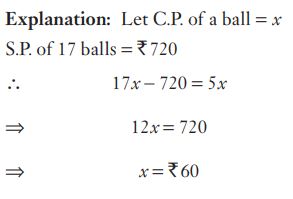
#41. A merchant sold an article for Rs 75 at a profit per cent equal to its cost price. The cost price of the article was :

#42. An article is sold at a gain of 15%. Had it been sold for Rs 27 more, the profit would have been 20%. The cost price of the article is :

#43. The difference between the selling prices of an article at a profit of 15% and at a profit of 10% is Rs 10. The cost price of the article is
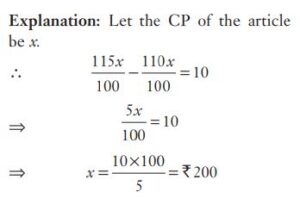
#44. A manufacturer fixes his selling price at 33% over the cost of production. If the cost of production goes up by 12% and the manufacturer raises his selling price by 10%, his percentage profit is :
